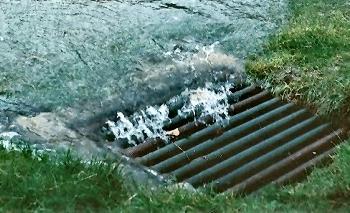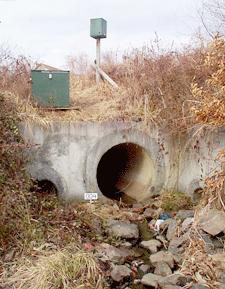Clean Water Advocacy - Newsroom - NACWA in the News
EPA Issues Wet Weather Policy Written By Enviros, Water Utilities
WASHINGTON, DC, December 19, 2005 (ENS) - Heavy rain and snow
storms can overwhelm municipal wastewater treatment systems, causing managers to
bypass secondary treatment, discharging inadequately treated sewage full of
pathogens. Today the U.S. Environmental Protection Agency announced a proposal
to solve the problem based on a joint draft by a U.S. environmental group and a
national wastewater utility trade association.
The new plan is an alternative to an earlier EPA proposal that generated protest
from public health and environmental organizations for being inadequate. In an
unusual move, the EPA responded last April by encouraging the Natural Resources
Defense Council (NRDC) and the National Association of Clean Water Agencies
(NACWA) to work together to solve the problem. The two organizations delivered
the plan to the EPA in late October.
NACWA and NRDC representatives were present this afternoon when Benjamin
Grumbles, U.S. Environmental Protection Agency (EPA) assistant administrator for
water, made the announcement at EPA Headquarters in Washington.

Heavy stormwater runoff can be too much for aging wastewater systems to handle.
(Photo courtesy Vermont DEC)
"Our peak flow policy puts a premium on stopping leaks and
spills, improving treatment, and increasing public oversight," said Grumbles. "I
commend environmentalists and utilities for working to find common ground on a
clean water solution that doesn't rely on dilution."
"Our joint effort produced a plan that goes a long way to protect public health,
and we're pleased that the EPA moved so quickly to endorse it," said Nancy
Stoner, director of NRDC's Clean Water Project. "More than seven million
Americans get sick from waterborne illnesses every year. Our solution will
ensure that those numbers come down."
"This is a tremendous success for the nation’s clean water future and shows that
progress can be made on tough issues when we work to find collaborative
solutions to difficult problems,” said NACWA Executive Director Ken Kirk. “EPA’s
release today demonstrates that sound policy can result when organizations stay
focused on the critical mission of improving water quality and protecting the
public health.
The original EPA proposal would have allowed wastewater facilities to discharge
inadequately treated sewage into waterways virtually anytime it rains.
The improved alternative negotiated by NRDC and NACWA will require wastewater
facilities to upgrade and repair their leaky sewage systems, and fully treat
sewage unless EPA or a state environmental agency determines there is no
feasible way to do so.
It also will require facility operators to notify the public and environmental
agencies any time they discharge inadequately treated sewage.
Many municipalities currently have situations in which peak flows during severe
storms exceed the treatment capacity of existing secondary treatment units. In
these situations, wet weather flows are sometimes diverted around secondary
treatment units and then either recombined with flows from the secondary
treatment units or discharged directly into waterways from the treatment plant.

Storm sewer in Fairfax County, Virginia (Photo courtesy Fairfax County)
The proposal only applies to those diversions as they are
recombined, and as they occur in separate sanitary sewer systems. Peak wet
weather diversions in combined sewer systems are already regulated in a similar
way under the 1994 Combined Sewer Overflow Policy.
NACWA, a national trade association representing hundreds of the nation's
publicly owned wastewater treatment utilities, says the EPA’s proposal would
benefit the nation’s water quality by minimizing the reliance of clean water
facilities on peak wet weather flow diversions as a long term management
approach.
NACWA members serve the majority of the sewered population in the United States
and collectively treat and reclaim over 18 billion gallons of wastewater every
day.
NACWA believes that the proposal’s enhanced public notice provisions will
improve the understanding and knowledge of peak wet weather flow diversion
practices at public utilities.
"This plan will make sure that treatment facilities warn the public when they
dump sewage into local waterways," said Stoner of NRDC, which claims 1.2 million
members and online activists. The plan also will commit the EPA to take
enforcement actions against sewer authorities that fail to properly maintain or
upgrade their facilities.
Health experts estimate that there are 7.1 million mild-to-moderate cases and
560,000 moderate-to-severe cases of infectious waterborne diseases in the United
States annually. Many of these cases are caused by exposure to sewage.
Untreated sewage contains a variety of dangerous pathogens, including bacteria
such as E coli, viruses such as hepatitis A, protozoa such as Cryptosporidium
and Giardia,and helminth worms.
The pathogens in sewage can cause illnesses ranging from diarrhea and vomiting
and respiratory infections to hepatitis and dysentery. Small children, the
elderly, cancer patients, and others with impaired immune systems are the most
likely to get sick.
Besides the obvious health threat, inadequately treating sewage has long-term
environmental and economic consequences. Sewage in waterways kills fish and
destroys shellfish beds. And it is the second largest known cause of U.S. beach
closures and advisories every year.
The proposed policy encourages municipalities to make investments in ongoing
maintenance and capital improvements to improve their systems' long term
performance.
The policy outlines the limited circumstances when these management techniques
can be used and how they must be documented in National Pollution Discharge
Elimination System (NPDES) permits. The policy also stipulates that all NPDES
permit limits must be met at all times.
"Our plan, which EPA adopted today, not only will help keep Americans healthy,
it will help keep our economy healthy," Stoner said. "And it shows that we can
work together to get the job done."
The draft policy will appear shortly in the Federal Register with a 30 day
comment period. NACWA says it is confident the public comments will demonstrate
broad support for EPA’s swift finalization of the policy.



